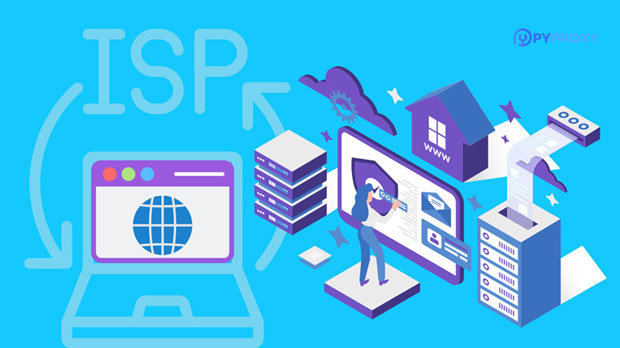Top 2025 residential SOCKS5 proxy recommendations for PYPROXY
In 2025, residential socks5 proxies have become a key tool for internet users seeking enhanced online privacy, security, and access to geographically restricted content. With the surge in demand for anonymous browsing, secure data transfers, and unrestricted access to the internet, the use of residential proxies has risen. These proxies, distinct from data center proxies, route traffic through real residential addresses, making them harder to detect and block. This article explores the factors driving the popularity of residential SOCKS5 proxies and provides an in-depth analysis of their functionality, benefits, and applications in modern internet usage. Understanding Residential SOCKS5 ProxiesResidential proxies are IP addresses that belong to real devices such as smartphones, laptops, and desktop computers. These devices are typically connected to residential internet services provided by ISPs. When users connect through residential proxies, their internet traffic appears to come from these actual devices, making it more difficult for websites and services to detect that the traffic is coming from a proxy server.SOCKS5 proxies, on the other hand, are a type of proxy that routes traffic at a lower level in the networking stack compared to HTTP or HTTPS proxies. SOCKS5 proxies offer several advantages, such as the ability to handle any type of internet traffic, including emails, FTP, and peer-to-peer (P2P) communications. They also support authentication, allowing users to add an extra layer of security to their connections.Why Residential SOCKS5 Proxies are Gaining Popularity in 2025Several factors have contributed to the increasing use of residential SOCKS5 proxies in 2025. Let’s break down the key reasons:1. Enhanced Anonymity and Privacy One of the most significant reasons users prefer residential SOCKS5 proxies is the level of anonymity they provide. Because residential proxies use real IP addresses, they are much harder to detect and block than data center proxies. Websites often associate proxy traffic with data centers, which are commonly used for malicious activities. However, traffic from residential IPs is harder to identify, making it a better choice for users looking to maintain privacy and avoid detection.2. Bypassing Geographical Restrictions Many internet users seek to access content that is restricted to certain regions, such as streaming services, social media, or local websites. Residential SOCKS5 proxies allow users to appear as if they are accessing the internet from a specific location, making it easier to bypass geographical restrictions. This is especially useful for individuals who want to access content in different countries or test how their website or service appears in various regions.3. Improved Success Rates for Web Scraping and Data Mining Residential SOCKS5 proxies are widely used for web scraping, a technique used to collect large amounts of data from websites. Unlike data center proxies, which can be easily blocked by websites, residential proxies are harder to detect. This improves the success rates of web scraping operations, as websites are less likely to flag or block requests from these proxies. As businesses increasingly rely on data-driven insights, the demand for effective web scraping tools powered by residential proxies continues to rise.4. Better Performance and Stability Residential SOCKS5 proxies tend to offer better stability and speed compared to other types of proxies. Since these proxies are routed through residential networks, they usually experience less downtime and are less likely to be blacklisted. This makes them more reliable for long-term use, especially for businesses and individuals who require consistent, uninterrupted access to online services.5. Support for Multiple Protocols Unlike HTTP or HTTPS proxies, SOCKS5 proxies support a wide variety of internet protocols. This includes TCP, UDP, and even protocols for peer-to-peer file sharing. As a result, residential SOCKS5 proxies are versatile and can be used for many different types of online activities, from streaming to gaming to secure browsing.Key Applications of Residential SOCKS5 ProxiesResidential SOCKS5 proxies are used in a variety of scenarios, and their applications span across personal, business, and professional domains. Some of the most common uses include:1. Secure Browsing and Online Privacy Individuals who prioritize online security use residential SOCKS5 proxies to mask their IP addresses and protect their personal information. By routing internet traffic through residential IPs, users can keep their online activities private, reducing the chances of being tracked by advertisers, hackers, or even government surveillance.2. Accessing Geo-Restricted Content Streaming platforms like Netflix, Hulu, and BBC iPlayer often limit access to content based on the user’s geographical location. Residential SOCKS5 proxies allow users to circumvent these restrictions and access content from other countries, making them a valuable tool for media consumption. Additionally, users can access websites that are otherwise restricted in certain regions, such as government portals or international news outlets.3. Web Scraping and Market Research Businesses that rely on market research and data collection use residential proxies to gather information from various sources without getting blocked. Residential SOCKS5 proxies allow web scrapers to collect data from websites at scale, helping companies analyze competitor information, monitor pricing strategies, and gather valuable insights for decision-making.4. Ad Verification and Brand Protection For digital marketers and businesses, ensuring that online ads appear correctly and without fraud is crucial. Residential proxies can be used to verify that ads are being shown in the correct regions and are not subject to fraud. They can also help brands protect their reputation by ensuring their advertisements are not being misused or abused.5. Enhanced E-commerce and Ticketing Residential SOCKS5 proxies are also popular in e-commerce and ticketing. Online retailers and ticketing platforms often limit how many items can be purchased from the same IP address in order to prevent scalping and bots from abusing the system. By using residential proxies, users can avoid these restrictions and increase their chances of purchasing high-demand items, such as concert tickets or limited-edition products.How to Choose the Best Residential socks5 proxy ServiceSelecting the right residential SOCKS5 proxy service is essential to getting the best performance and results. Here are some factors to consider:1. IP Pool Size and Diversity A large and diverse IP pool ensures that users can access a wide range of locations, which is important for bypassing geo-restrictions and conducting web scraping without being blocked. Look for providers with extensive residential IP networks across multiple regions.2. Speed and Latency While residential SOCKS5 proxies offer better anonymity, speed and latency can vary based on the quality of the provider’s network. It’s crucial to choose a service that offers high-speed connections to ensure smooth browsing and data transfers.3. Reliability and Uptime Proxies should be reliable, with minimal downtime. High-quality residential proxy services will offer a stable connection, reducing the risk of interruptions during critical online tasks such as web scraping or accessing restricted content.4. Security Features Ensure that the service provides adequate security measures, including encryption and authentication options, to keep your data secure while using the proxy. Security is especially important for sensitive operations like online banking or accessing private business information.5. Customer Support A responsive and knowledgeable customer support team can help resolve issues promptly, ensuring that you can continue using the service without significant disruptions.ConclusionAs we move into 2025, residential SOCKS5 proxies have proven to be an indispensable tool for users looking to protect their online privacy, bypass geo-restrictions, and ensure secure data transactions. With their ability to provide anonymity, reliability, and high performance, they are well-suited to meet the growing demands of internet users in various industries. Whether you're an individual looking to maintain privacy while browsing, a business conducting market research, or an e-commerce platform ensuring fair transactions, residential SOCKS5 proxies offer significant value in today’s digital landscape.
2025-01-07

























































